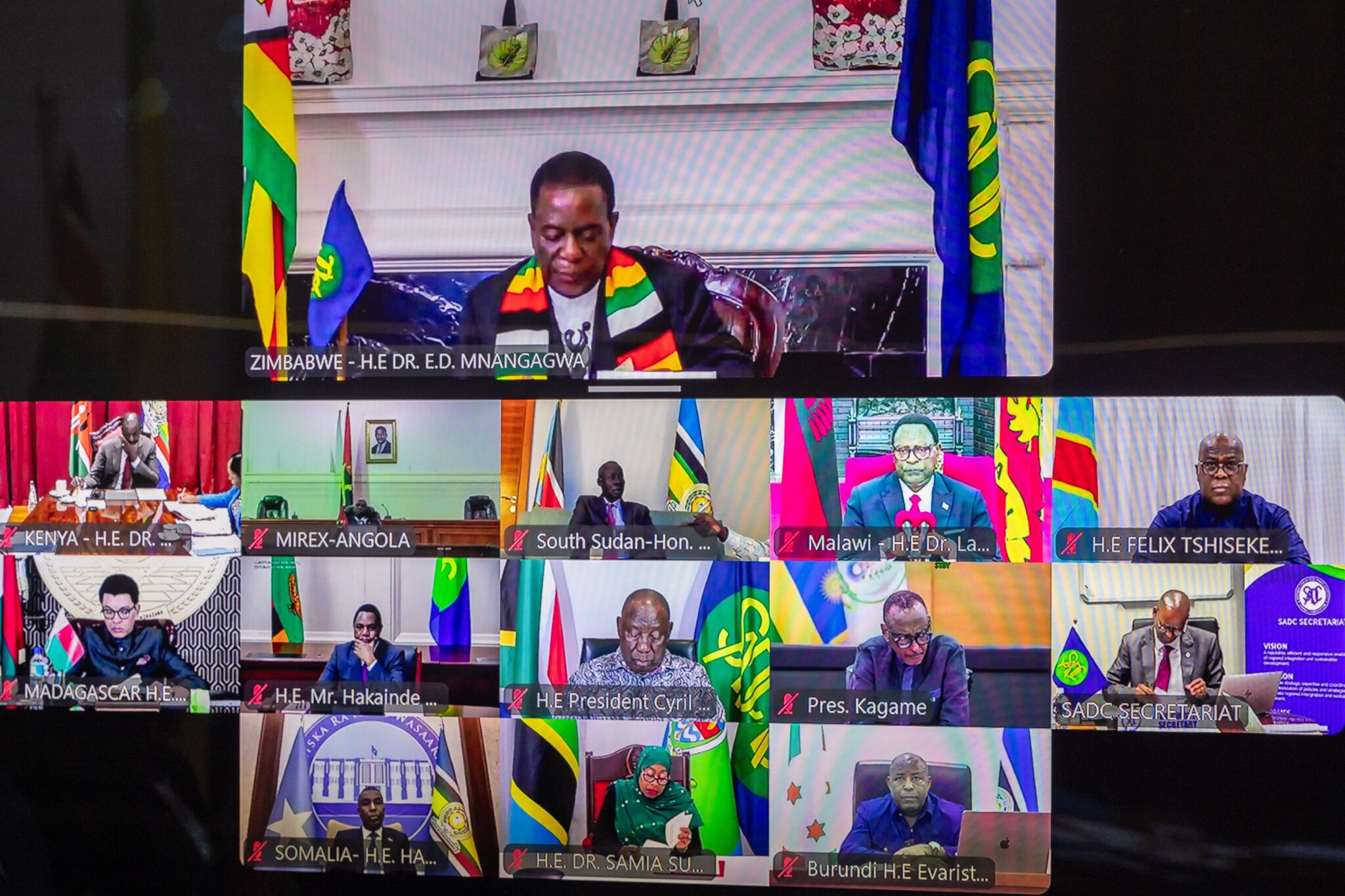
President William Ruto and Zimbabwe’s President Emmerson Mnangagwa co-chair a virtual Joint Summit of EAC and SADC Heads of State and Government on March 24, 2025, to address the ongoing conflict in Eastern DRC. The leaders resolved to expedite the peace process by appointing an expanded panel of facilitators and adopting a roadmap for sustainable security in the region. Photo/PCS
By Wanderi Kamau
The Joint Summit of the Heads of State and Government of the East African Community (EAC) and the Southern African Development Community (SADC) convened a virtual meeting on March 24, 2025, to discuss the security situation in the Eastern Democratic Republic of the Congo (DRC).
The meeting, held in a warm and cordial atmosphere, was co-chaired by Kenya’s president William Samoei Ruto, who is also the EAC’s chairperson, and Zimbabwe’s Emmerson Mnangagwa, who is also SADC’s chairperson.
High-level participation
The Joint Summit was attended by several Heads of State and Government, including President’s Félix Tshisekedi (DRC), Évariste Ndayishimiye (Burundi,) Andry Rajoelina (Madagascar), Lazarus Chakwera (Malawi), Paul Kagame (Rwanda), Cyril Ramaphosa (South Africa) and Samia Suluhu Hassan of Tanzania.
Read more: IGAD Special Envoy, SSOMA hold meeting in Rome over S/Sudan
Also, in attendance were President Yoweri Museveni of Uganda, Hakainde Hichilema (Zambia) and representatives from Somalia, Angola, and South Sudan. The EAC and SADC Ministers, along with the Executive Secretary of SADC and the Secretary General of the EAC, also participated in the discussions.
Reviewing past resolutions
The leaders recalled the resolutions from the first Joint EAC-SADC Summit held in Dar es Salaam on February 8, 2025, as well as key decisions made at the African Union’s Peace and Security Council meeting on February 14, 2025, and the UN Security Council Resolution 2773 of February 21, 2025. These prior resolutions underscored the urgent need for coordinated efforts to address the worsening security crisis in eastern DRC.
Adoption of roadmap for peace
The Joint Summit adopted the report from the Joint EAC-SADC Meeting of Ministers, which was held on March 17, 2025, in Harare, Zimbabwe. The report includes findings from the Joint Meeting of Chiefs of Defence and outlines a comprehensive roadmap comprising immediate, medium-term, and long-term measures to achieve sustainable peace and security in the eastern DRC. The Summit directed that the implementation of these measures be expedited.
Appointment of facilitators
To oversee the peace process, the Joint Summit appointed a distinguished panel of facilitators, taking into account gender, regional, and language inclusivity. The panel includes:
- Olusegun Obasanjo, former President of Nigeria
- Uhuru Kenyatta, former President of Kenya
- Kgalema Motlanthe, former President of South Africa
- Catherine Samba Panza, former President of the Central African Republic
- Sahle-Work Zewde, former President of Ethiopia
The EAC and SADC Secretariats have been tasked with notifying the appointed facilitators and conveying the Summit’s resolutions to the African Union and the United Nations Security Council.
Next steps and appreciation
The Joint Summit directed its co-chairs to convene a briefing session with the facilitators within the next seven days. This session will be jointly coordinated by SADC, EAC, and the African Union. The Summit expressed its gratitude to the Chairpersons of EAC and SADC for their leadership in advancing efforts toward lasting peace and security in the region. Appreciation was also extended to the EAC and SADC Secretariats for their role in organizing the Summit.
Read more: Ruto, Rubio push for peace in Eastern DRC
The resolutions and directives from the Joint Summit mark a crucial step in addressing the long-standing security challenges in eastern DRC.
The successful implementation of the adopted roadmap is expected to pave the way for stability and sustainable peace in the region. The meeting concluded with the adoption of its resolutions in English, French, and Portuguese, ensuring inclusivity among member states.



